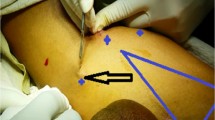Abstract
Background
Lymphadenectomy is a surgical technique for staging and treating cancer. Laparoscopic lymphadenectomy for obese patients is challenging. Laparoscopic ultrasound-assisted liposuction (UAL) has been successful in porcine models. The current study aimed to evaluate whether UAL facilitates pelvic laparoscopic lymphadenectomy in obese subjects.
Methods
The UAL technique was evaluated in two human cadavers and in six obese Ossabaw pigs. Both a standard and a prototype ultrasonic probe with a wider contact surface were tested. Pelvic lymphadenectomy comparing UAL with standard monopolar cautery was performed using obese Ossabaw pigs. The animals were survived for 2 weeks. Descriptive data regarding intra- and postoperative outcomes were recorded, including histologic analysis of dissected tissue after 2 weeks. Cytologic analysis of aspirated fluid coming from UAL also was recorded.
Results
The UAL procedure was safely performed for all the cadavers and animals. Lymph node exposure and clean exposure of surrounding structures were dramatic compared with monopolar assisted dissection. One animal was excluded from further analysis due to ultrasonic device malfunction (a broken footswitch cord). In general, UAL notably debulks adipose tissue with dramatic field exposure. Postoperative adhesions were present in all animals undergoing either monopolar or UAL dissection. Histology showed areas of foreign body reaction from mild to severe, with no predominance of either extreme seen with monopolar or UAL dissection. Cytologic analysis of collected pooled oil emulsion did not contain lymph node tissue.
Conclusion
The UAL approach permits pelvic lymphadenectomy in the obese animal and cadaver model, with excellent exposure of lymph nodes and surrounding pelvic anatomy. The use of a new ultrasonic prototype probe with a wider contact surface allowed dissection with less mechanical and thermal penetration of tissue. Further studies are needed to assess oncologic safety (cancer cell dissemination), postoperative healing, and adhesion formation.




Similar content being viewed by others
References
Briganti A, Blute ML, Eastham JH, Graefen M, Heidenreich A, Karnes JR, Montorsi F, Studer UE (2009) Pelvic lymph node dissection in prostate cancer. Eur Urol 55:1251–1265
Mettler L, Meinhold-Heerlein I (2009) The value of laparoscopic surgery to stage gynecological cancers: present and future. Minerva Ginecol 61:319–337
Steiner H, Peschel R, Bartsch G (2009) Laparoscopic retroperitoneal lymph node dissection: current concepts and limitations. BJU Int 104:1376–1380
Goldfarb M, Brower S, Schwaitzberg SD (2010) Minimally invasive surgery and cancer: controversies part 1. Surg Endosc 24:304–334
Yabuki Y, Asamoto A, Hoshiba T, Nishimoto H, Satou N (1996) A new proposal for radical hysterectomy. Gynecol Oncol 62:370–378
Höckel M, Konerding MA, Heussel CP (1998) Liposuction-assisted nerve-sparing extended radical hysterectomy: oncologic rationale, surgical anatomy, and feasibility study. Am J Obstet Gynecol 178:971–976
Sumiyama K, Utsunomiya K, Ohya T, Aihara H, Ikeda K, Imazu H, Tamai N, Nagano H, Ishinoda Y, Tajiri H (2011) A pilot study on ultrasound-assisted liposuction of the greater omentum in porcine models. Minim Invasive Ther Allied Technol. doi:10.3109/13645706.2011.557384
Illouz YG (1983) Body contouring by lipolysis: a 5-year experience with over 3,000 cases. Plast Reconstr Surg 72:591–597
Zocchi, ML (1988) New perspective in lipoplasty: the ultrasonic-assisted lipectomy (UAL). Presented at the congress of the French society of aesthetic surgery, Paris, May 1988
Heymans O, Castus P, Grandjean FX, Van Zele D (2006) Liposuction: review of the techniques, innovations, and applications. Acta Chir Belg 106:647–653
Faga A, Valdatta L, Mezzetti M, Buoro M, Thione A (2002) Ultrasound-assisted lipolysis of the omentum in dwarf pigs. Aesthetic Plast Surg 26:193–196
Ablaza VJ, Gingrass MK, Perry LC, Fisher J, Maxwell GP (1998) Tissue temperatures during ultrasound-assisted lipoplasty. Plast Reconstr Surg 102:534–542
Nahhas WA (1991) A potential hazard of the use of the surgical ultrasonic aspirator in tumor reductive surgery. Gynecol Oncol 40:81–83
Nduka CC, Poland N, Kennedy M, Dye J, Darzi A (1998) Does the ultrasonically activated scalpel release viable airborne cancer cells? Surg Endosc 12:1031–1034
Rose PG (1992) The cavitational ultrasonic surgical aspirator for cytoreduction in advanced ovarian cancer. Am J Obstet Gynecol 166:843–846
Camanni M, Bonino L, Delpiano EM, Migliaretti G, Berchialla P, Deltetto F (2010) Laparoscopy and body mass index: feasibility and outcome in obese patients treated for gynecologic diseases. J Minim Invasive Gynecol 17:576–582 Epub 8 July 2010
Kenkel JM, Robinson JB Jr, Beran SJ, Tan J, Howard BK, Zocchi ML, Rohrich RJ (1998) The tissue effects of ultrasound-assisted lipoplasty. Plast Reconstr Surg 102:213–220
Acknowledgment
The authors acknowledge Drs. Gretchen Gleiser and Sanjeev Kumar for their assistance with the experiments. The authors also acknowledge Drs. Jordan Reynolds and Ronald Marler for the cytologic and pathologic analysis. This work was supported by Olympus Japan.
Disclosures
Christopher J. Gostout and the Developmental Endoscopy Unit receive research grant support from Olympus America and Olympus Tokyo. Dr. Gostout is an advisor to Apollo Endosurgery (Austin,Tx) and a consultant to Vysera (Galway, Ireland). Both he and the Mayo Foundation maintain an equity position in Apollo Endosurgery, Inc. Eduardo A Bonin, Andrea Mariani, James Swain, Juliane Bingener, Kazuki Sumiyama, Mary Knipschield, and Thomas J. Sebo have no conflicts of interest or financial ties to disclose.
Author information
Authors and Affiliations
Corresponding author
Rights and permissions
About this article
Cite this article
Bonin, E.A., Mariani, A., Swain, J. et al. Laparoscopic ultrasound-assisted liposuction for lymph node dissection: a pilot study. Surg Endosc 26, 1963–1970 (2012). https://doi.org/10.1007/s00464-011-2136-9
Received:
Accepted:
Published:
Issue Date:
DOI: https://doi.org/10.1007/s00464-011-2136-9




